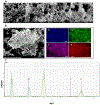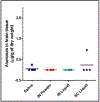Intranasal immunization with aluminum salt-adjuvanted dry powder vaccine
- PMID: 30339906
- PMCID: PMC6328263
- DOI: 10.1016/j.jconrel.2018.10.020
Intranasal immunization with aluminum salt-adjuvanted dry powder vaccine
Abstract
Intranasal vaccination using dry powder vaccine formulation represents an attractive, non-invasive vaccination modality with better storage stability and added protection at the mucosal surfaces. Herein we report that it is feasible to induce specific mucosal and systemic antibody responses by intranasal immunization with a dry powder vaccine adjuvanted with an insoluble aluminum salt. The dry powder vaccine was prepared by thin-film freeze-drying of a model antigen, ovalbumin, adsorbed on aluminum (oxy)hydroxide as an adjuvant. Special emphasis was placed on the characterization of the dry powder vaccine formulation that can be realistically used in humans by a nasal dry powder delivery device. The vaccine powder was found to have "passable" to "good" flow properties, and the vaccine was uniformly distributed in the dry powder. An in vitro nasal deposition study using nasal casts of adult humans showed that around 90% of the powder was deposited in the nasal cavity. Intranasal immunization of rats with the dry powder vaccine elicited a specific serum antibody response as well as specific IgA responses in the nose and lung secretions of the rats. This study demonstrates the generation of systemic and mucosal immune responses by intranasal immunization using a dry powder vaccine adjuvanted with an aluminum salt.
Keywords: Aluminum salts; Dry powder; Intranasal; Mucosal immunity; Powder characterization; Vaccine.
Copyright © 2018 Elsevier B.V. All rights reserved.
Figures







Similar articles
-
Nasal aluminum (oxy)hydroxide enables adsorbed antigens to induce specific systemic and mucosal immune responses.Hum Vaccin Immunother. 2017 Nov 2;13(11):2688-2694. doi: 10.1080/21645515.2017.1365995. Epub 2017 Sep 21. Hum Vaccin Immunother. 2017. PMID: 28933668 Free PMC article.
-
Immunogenicity of Antigen Adjuvanted with AS04 and Its Deposition in the Upper Respiratory Tract after Intranasal Administration.Mol Pharm. 2020 Sep 8;17(9):3259-3269. doi: 10.1021/acs.molpharmaceut.0c00372. Epub 2020 Aug 27. Mol Pharm. 2020. PMID: 32787271
-
The immunogenicity of thin-film freeze-dried, aluminum salt-adjuvanted vaccine when exposed to different temperatures.Hum Vaccin Immunother. 2017 Apr 3;13(4):936-946. doi: 10.1080/21645515.2016.1259042. Epub 2017 Jan 4. Hum Vaccin Immunother. 2017. PMID: 28051903 Free PMC article.
-
Dry powder vaccines for mucosal administration: critical factors in manufacture and delivery.Curr Top Microbiol Immunol. 2012;354:121-56. doi: 10.1007/82_2011_167. Curr Top Microbiol Immunol. 2012. PMID: 21822816 Review.
-
Dry powder nasal vaccines as an alternative to needle-based delivery.Crit Rev Ther Drug Carrier Syst. 2009;26(1):1-27. doi: 10.1615/critrevtherdrugcarriersyst.v26.i1.10. Crit Rev Ther Drug Carrier Syst. 2009. PMID: 19496746 Review.
Cited by
-
Progress on Thin Film Freezing Technology for Dry Powder Inhalation Formulations.Pharmaceutics. 2022 Nov 28;14(12):2632. doi: 10.3390/pharmaceutics14122632. Pharmaceutics. 2022. PMID: 36559129 Free PMC article. Review.
-
Modulation of Chitosan-TPP Nanoparticle Properties for Plasmid DNA Vaccines Delivery.Polymers (Basel). 2022 Apr 1;14(7):1443. doi: 10.3390/polym14071443. Polymers (Basel). 2022. PMID: 35406316 Free PMC article.
-
Lipopeptide adjuvants for antibiotics and vaccines: the future step in the fight against multidrug-resistant and extensively drug-resistant pathogens.Explor Drug Sci. 2024;2:203-233. doi: 10.37349/eds.2024.00043. Epub 2024 Apr 29. Explor Drug Sci. 2024. PMID: 40842601 Free PMC article.
-
Preparation of Protein Aerogel Particles for the Development of Innovative Drug Delivery Systems.Gels. 2022 Nov 24;8(12):765. doi: 10.3390/gels8120765. Gels. 2022. PMID: 36547289 Free PMC article.
-
Intratracheal inoculation of AHc vaccine induces protection against aerosolized botulinum neurotoxin A challenge in mice.NPJ Vaccines. 2021 Jun 22;6(1):87. doi: 10.1038/s41541-021-00349-w. NPJ Vaccines. 2021. PMID: 34158496 Free PMC article.
References
-
- Mbow ML, De Gregorio E, Valiante NM, Rappuoli R. New adjuvants for human vaccines. Curr Opin Immunol. 2010. June;22(3):411–6. PubMed PMID: . - PubMed
-
- O’Hagan Derek T., MacKichan Mary Lee, Singh M Recent developments in adjuvants for vaccines against infectious diseases. Biomolecular Engineering. 2001;18:69–85. - PubMed
-
- Singh Manmohan, O’Hagan D Advances in vaccine adjuvants. Nature Biotechnology. 1999;17:1075–81. - PubMed
-
- Milstien JB, Kartoglu Um, Zaffran M, Galazka AM. Temperature sensitivity of vaccines. World Health Organization; 2006;WHO/IVB/06.10.
Publication types
MeSH terms
Substances
Grants and funding
LinkOut - more resources
Full Text Sources
Other Literature Sources
Medical
Miscellaneous

